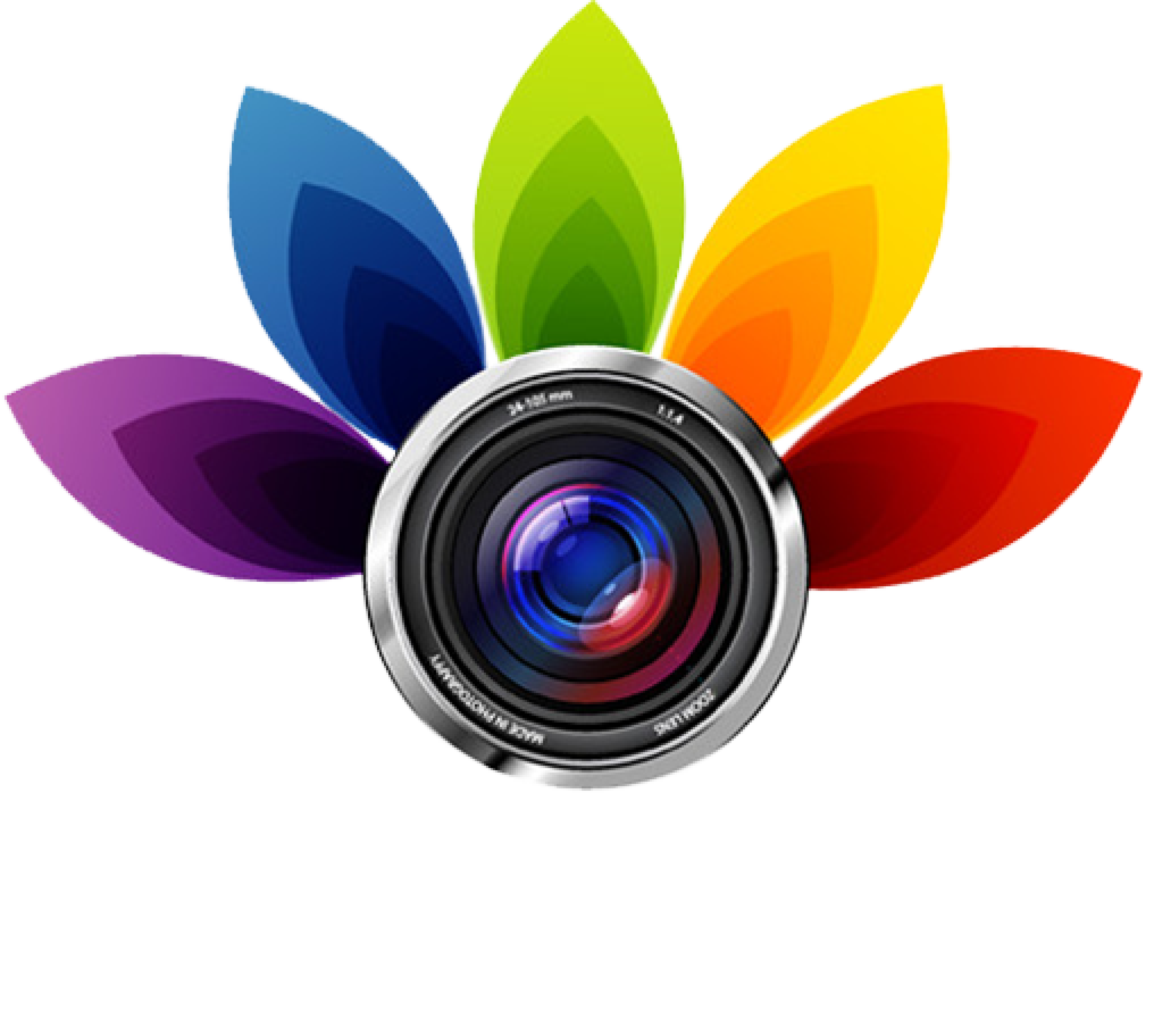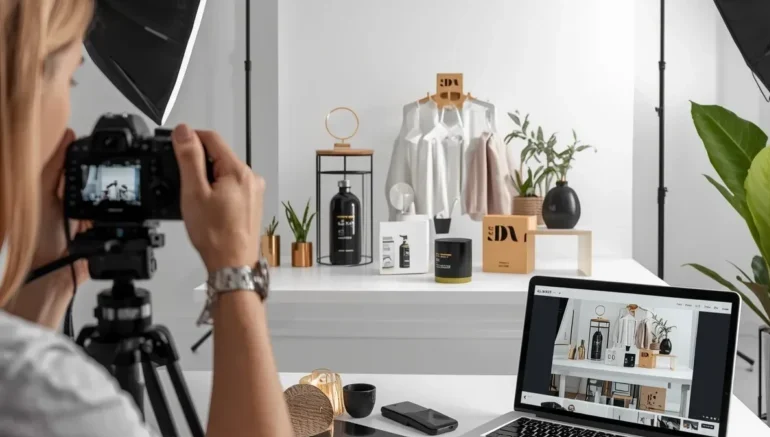
Best Cameras for E-Commerce Product Photography in 2026
In 2026, E-Commerce product photography is more important than ever. Online shoppers rely heavily on clear, high-quality images to make buying decisions, and poor visuals can turn potential customers away. Choosing the right camera can make a huge difference in how your products appear, helping them look professional, detailed, and appealing. From small online shops to large brands, having the best gear makes your products stand out in a crowded marketplace. With so many camera options available, it can be challenging to find one that meets your needs without breaking the bank.
This guide will help you discover the top cameras designed specifically for product photography in e-commerce. We’ll cover options that fit different skill levels, budgets, and shooting styles, from compact mirrorless models to high-end medium-format cameras. Each camera on this list has been chosen for its sharp image quality, accurate colors, and reliable performance, all key for taking products that sell. If you’re photographing jewelry, clothing, electronics, or food, these cameras are built to handle it all. By the end, you’ll have a clearer idea of which models can improve your product photography and make your online store shine.
Why Your Camera Matters in E-Commerce Product Photography
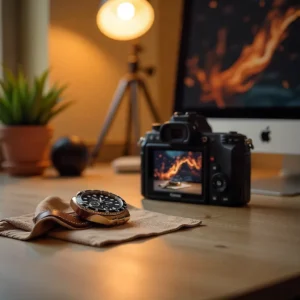 The camera you use plays a big role in how your products look online. High-quality images help customers see details clearly, which builds trust and can boost sales. A good camera photographs accurate colors, sharp lines, and the fine textures of your products. On the other hand, a low-quality camera may produce blurry or dull photos, making your products look less appealing. Investing in the right camera makes sure that your online store looks professional and attracts more buyers. Even small improvements in image clarity can make a noticeable difference in how customers perceive your products.
The camera you use plays a big role in how your products look online. High-quality images help customers see details clearly, which builds trust and can boost sales. A good camera photographs accurate colors, sharp lines, and the fine textures of your products. On the other hand, a low-quality camera may produce blurry or dull photos, making your products look less appealing. Investing in the right camera makes sure that your online store looks professional and attracts more buyers. Even small improvements in image clarity can make a noticeable difference in how customers perceive your products.
Using the right camera also saves time in editing and retouching. When images are clear and vibrant from the start, you spend less time fixing mistakes later. Some key things to look for in a camera for e-commerce include resolution, color accuracy, and autofocus speed.
You can also improve your product photos with simple tips:
- Use natural or soft lighting to highlight details
- Keep the camera steady with a tripod or stable surface
- Shoot from multiple angles to give customers a full view
- Clean the lens regularly to avoid blurry spots
Must-Have Camera Features for Product Photography
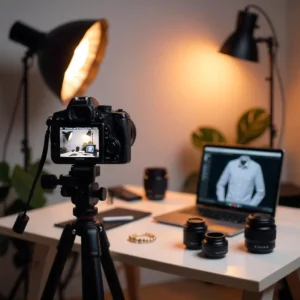 When choosing a camera for e-commerce product photography, it’s important to know what features make a difference. The right features can help your products look sharp, clear, and true to life. One of the most important is image resolution, which determines how detailed your photos will be. Cameras with higher resolution take finer details, making jewelry, clothing, and other products stand out. Another key feature is auto-focus, which helps the camera quickly focus on your product and avoid blurry shots. A camera that handles colors well is also important so that your products look realistic online.
When choosing a camera for e-commerce product photography, it’s important to know what features make a difference. The right features can help your products look sharp, clear, and true to life. One of the most important is image resolution, which determines how detailed your photos will be. Cameras with higher resolution take finer details, making jewelry, clothing, and other products stand out. Another key feature is auto-focus, which helps the camera quickly focus on your product and avoid blurry shots. A camera that handles colors well is also important so that your products look realistic online.
Other helpful features can make your workflow easier and improve your photos:
- In-body image stabilization – reduces blur from small hand movements
- Good low-light performance – keeps your photos vibrant without harsh lighting
- Interchangeable lenses – allows you to switch lenses for different types of products
- Manual controls – gives flexibility to adjust settings for the perfect shot
Best Cameras for Beginners
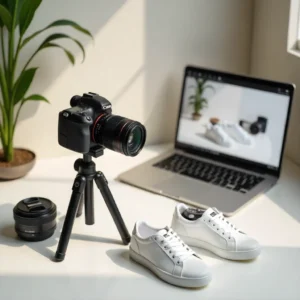 Starting out in e-commerce product photography means picking a camera that is simple to use, produces clear images, and fits your budget. Popular beginner options include the Canon EOS Rebel SL3, Nikon D3500, and Canon EOS R100 because they offer good image quality, easy controls, and useful features like vari-angle touchscreens and 4K video. Mirrorless cameras such as the Olympus OM-D E-M10 Mark IV and Nikon Z fc are also great choices, thanks to their compact designs, in-body stabilization, and flexible shooting angles. These cameras give beginners room to learn and grow without feeling complicated or expensive.
Starting out in e-commerce product photography means picking a camera that is simple to use, produces clear images, and fits your budget. Popular beginner options include the Canon EOS Rebel SL3, Nikon D3500, and Canon EOS R100 because they offer good image quality, easy controls, and useful features like vari-angle touchscreens and 4K video. Mirrorless cameras such as the Olympus OM-D E-M10 Mark IV and Nikon Z fc are also great choices, thanks to their compact designs, in-body stabilization, and flexible shooting angles. These cameras give beginners room to learn and grow without feeling complicated or expensive.
Here are some tips to get the most from a beginner camera:
- Start with a kit lens that covers multiple focal lengths for versatile shots.
- Learn basic manual settings like ISO, shutter speed, and aperture to control your images.
- Use a tripod to keep your shots steady, especially in low light.
- Practice regularly to improve your skills and get comfortable with your camera.
- Edit your photos lightly to make your products look polished and professional.
Best Cameras for Professionals
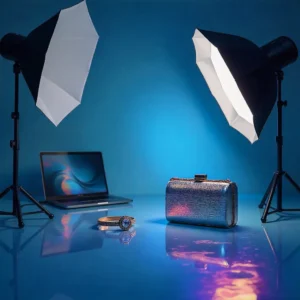 For professional e-commerce product photography, image quality and advanced features are key. Professional cameras are designed to photograph fine details, accurate colors, and sharp images that make products look their best online. High-resolution sensors and fast autofocus systems allow photographers to work efficiently, even in complex lighting conditions. Cameras like the Canon EOS R5, Sony A7 IV, and Nikon Z7 II are popular among professionals because they combine speed, precision, and versatility.
For professional e-commerce product photography, image quality and advanced features are key. Professional cameras are designed to photograph fine details, accurate colors, and sharp images that make products look their best online. High-resolution sensors and fast autofocus systems allow photographers to work efficiently, even in complex lighting conditions. Cameras like the Canon EOS R5, Sony A7 IV, and Nikon Z7 II are popular among professionals because they combine speed, precision, and versatility.
Mirrorless cameras are also favored for their lightweight design and advanced video capabilities, giving professionals more flexibility in different shooting environments. Professional photographers can get even better results by using the right accessories and settings:
- Use prime lenses for sharper images and better depth of field
- Invest in studio lighting or soft boxes to control shadows and highlights
- Shoot in RAW format to have more flexibility in post-processing
- Use a sturdy tripod to keep images steady during detailed product shoots
- Regularly calibrate your monitor to make sure that colors are accurate
Mirrorless vs DSLR for E-Commerce Product Photography
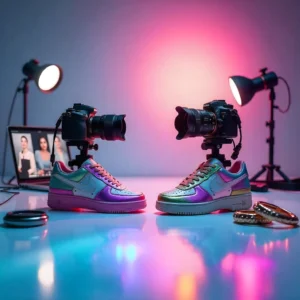 When choosing a camera for e-commerce product photography, understanding the difference between mirrorless and DSLR cameras is important. DSLRs have been around for years and are known for their reliability, long battery life, and large selection of lenses. They use a mirror system to reflect the image into the viewfinder, which many photographers find helpful for precise framing. Mirrorless cameras, on the other hand, do not have a mirror system, which makes them smaller, lighter, and often faster when it comes to autofocus and shooting speed. Both types can produce high-quality images, but the choice depends on your needs, budget, and shooting style.
When choosing a camera for e-commerce product photography, understanding the difference between mirrorless and DSLR cameras is important. DSLRs have been around for years and are known for their reliability, long battery life, and large selection of lenses. They use a mirror system to reflect the image into the viewfinder, which many photographers find helpful for precise framing. Mirrorless cameras, on the other hand, do not have a mirror system, which makes them smaller, lighter, and often faster when it comes to autofocus and shooting speed. Both types can produce high-quality images, but the choice depends on your needs, budget, and shooting style.
Here are some tips to consider when deciding between the two:
- DSLR: Great for photographers who prefer a traditional viewfinder and longer battery life.
- Mirrorless: Ideal for those who need a compact camera and faster performance in continuous shooting.
- Lenses: Make sure the camera system has compatible lenses for your products.
- Weight and portability: Mirrorless cameras are easier to carry for long shoots or small studios.
- Future-proofing: Mirrorless cameras are becoming the standard in the industry and often include advanced features like in-body stabilization.
Extra Tools That Improve Your Product Shots
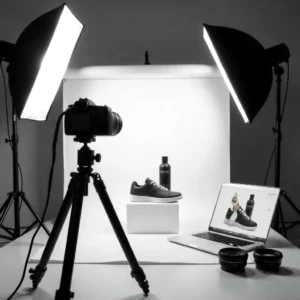 Using the right tools can make a big difference in e-commerce product photography. Accessories like tripods, lighting kits, and specialized lenses help you photograph sharper, more professional-looking images. A tripod keeps your camera steady, which is especially useful for small products or long exposure shots. Proper lighting, such as soft boxes or LED panels, makes sure that your products are evenly lighted and colors appear accurate. Using a clean backdrop or lightbox can also make your products stand out and look more appealing to customers.
Using the right tools can make a big difference in e-commerce product photography. Accessories like tripods, lighting kits, and specialized lenses help you photograph sharper, more professional-looking images. A tripod keeps your camera steady, which is especially useful for small products or long exposure shots. Proper lighting, such as soft boxes or LED panels, makes sure that your products are evenly lighted and colors appear accurate. Using a clean backdrop or lightbox can also make your products stand out and look more appealing to customers.
Here are some extra tools and tips to improve your product images:
- Tripod – Stabilizes your camera for sharper photos and consistent framing.
- Soft box or LED lights – Helps control shadows and highlight product details.
- Reflectors – Bounce light to reduce harsh shadows and brighten small areas.
- Lightbox or clean background – Makes products pop and gives a professional look.
- Different lenses – Macro or prime lenses photograph fine details for jewelry, electronics, or small items.
Tips for Getting the Best Photos
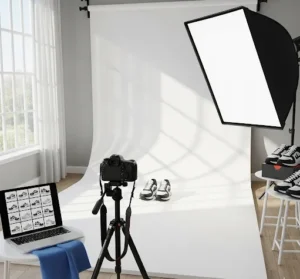 Taking great e-commerce product photos requires more than just a good camera. Simple adjustments and techniques can make your products look more attractive and professional. Start by setting up proper lighting, either with natural light or soft artificial lights, to highlight product details and avoid harsh shadows. Make sure your camera is steady using a tripod or stable surface to prevent blurry shots. Framing your products well and shooting from different angles helps customers see the item clearly and feel confident about their purchase. Paying attention to small details, like cleaning your products and background, also makes a big difference in the final image.
Taking great e-commerce product photos requires more than just a good camera. Simple adjustments and techniques can make your products look more attractive and professional. Start by setting up proper lighting, either with natural light or soft artificial lights, to highlight product details and avoid harsh shadows. Make sure your camera is steady using a tripod or stable surface to prevent blurry shots. Framing your products well and shooting from different angles helps customers see the item clearly and feel confident about their purchase. Paying attention to small details, like cleaning your products and background, also makes a big difference in the final image.
Here are some tips to improve your product photography:
- Use natural or soft lighting to make colors look accurate and details clear.
- Shoot from multiple angles to give customers a full view of the product.
- Keep the background simple and clean so the product stands out.
- Adjust camera settings like ISO, aperture, and shutter speed for sharper images.
- Take multiple shots and select the best ones to use online.
Thoughts on Choosing a Camera
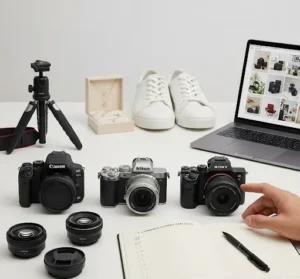 Choosing the right camera for product photography is an important step in creating professional and appealing images. The best camera depends on your experience level, budget, and the type of products you sell. Beginners may prefer cameras that are easy to use and affordable, while professionals may invest in high-resolution models with advanced features. Remember that a camera alone won’t guarantee great photos; use proper lighting, lenses, and accessories also plays a big role. Take the time to try different cameras, and find one that feels comfortable for your workflow.
Choosing the right camera for product photography is an important step in creating professional and appealing images. The best camera depends on your experience level, budget, and the type of products you sell. Beginners may prefer cameras that are easy to use and affordable, while professionals may invest in high-resolution models with advanced features. Remember that a camera alone won’t guarantee great photos; use proper lighting, lenses, and accessories also plays a big role. Take the time to try different cameras, and find one that feels comfortable for your workflow.
Here are some tips to keep in mind when selecting a camera:
- Match your budget with your needs – Choose a camera that balances cost with needed features.
- Consider future growth – Pick a camera system that allows you to upgrade lenses or accessories later.
- Focus on image quality – Sharpness, color accuracy, and detail are key for product photos.
- Try before buying – Test cameras in-store or rent models to see how they handle your products.
- Think about workflow – Choose a camera that makes shooting, transferring, and editing photos easier.
Conclusion
E-commerce product photography in 2026 is all about making your products look clear, professional, and appealing to customers. Choosing the right camera, using proper lighting, and adding the right tools can make a big difference in how your products are seen online. If you’re a beginner or a professional, there’s a camera and setup that fits your needs and budget. We’d love to hear from you; what camera or tools do you use for your product photography, and which tips have helped you the most? Share your experiences and questions in the comments below, and let’s start a conversation about creating better product images together. Your insights could help other sellers improve their photos and grow their online business.
Read Next: Balance AI Automation with Manual Creativity in Photo Editing
